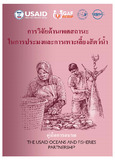| dc.description | Gender is an encompassing issue that refers to how we should look at everything in certain ways, especially on the economic, social, political, and cultural features and opportunities concerning men and women, and on the impacts of those aspects on them. More specifically, gender refers to how we should look at the particular characteristics and roles of men and women at every level, whatever the society or community deems necessary and considers priority.
Taking into account the need to mainstream gender concerns in designing and implementing programs and activities, especially the equality of men and women in accessing resources and opportunities, gender has been treated as a cross-cutting issue in the ASEAN-SEAFDEC Plan of Action on Sustainable Fisheries for Food Security for the ASEAN Region Towards 2030.
More specifically, in the Strategies of SEAFDEC Towards 2030, Strategy 5 indicates the importance of “Addressing cross-cutting issues, such as labor, gender, and climate change, where related to international fisheries” by giving “cognizance of the importance of small-scale fisheries, welfare of labor in fisheries, safety at sea, and gender equality in the fisheries and aquaculture sector.”
Furthermore, in the Voluntary Guidelines for Securing Sustainable Small-Scale Fisheries in the Context of Food Security and Poverty Eradication (SSF Guidelines), it is emphasized that the objectives of the Guidelines could be achieved through the promotion of a human rightsbased approach, by empowering small-scale fishing communities – including both men and women, to participate in decision-making processes and to assume responsibilities for sustainable use of fishery resources. In order to be able to respond to the provisions of the SSF Guidelines, let us first look at the scenario of the world’s fishers.
Records have shown that 90% of the world’s fishers work in the small-scale fisheries sector and 70% of the global fish catch comes from small-scale fisheries, with a further 200-300 million people, many of whom are women, working in the fisheries value chains (Kolding et al., 2014) and 50% of women globally in processing and trade (FAO, 2011). Within the Asian seafood industry, 60% of the women in involved in small-scale fisheries, especially in such activities as mending of fishing gears, post-harvesting, fish processing, and trading. In addition to carrying out such productive roles in fishing-related activities, women are also primarily performing reproductive roles such as childcare and other household chores. However, it is also evident that women are not given the opportunities to hold managerial and decisionmaking posts due to the assumption that women lack confidence in their capabilities to hold such positions and have insufficient time to do so. As a result, women in fisheries particularly in Southeast Asia, are being vulnerable to poverty, health risks, natural disasters, and climate change, as well as experiencing inequitable division of household works, limited access to education, and unequal rights. (FAO, 2011).
Generally, in the Southeast Asian societies, women’s roles in fisheries are not well recognized, and usually overlooked or under-represented in the official documents and statistics. Documentation of women’s contributions to the fisheries (e.g., value chain in small-scale fisheries and aquaculture) continues to be a challenge because of the informal nature of their work. Thus, the SSF Guidelines recommend that gender mainstreaming should be made an integral part of all small-scale fisheries development strategies, which should take into consideration the different cultural contexts and challenging practices that are discriminatory against women. On the part of SEAFDEC, the “Practical Guide for Gender Analysis in Small-scale Fisheries and Aquaculture in Southeast Asia (Practical Guide)” had been developed to implement the “SEAFDEC Gender Strategy on Integrating Gender in SEAFDEC Programs and Projects (SEAFDEC Gender Strategy)” which provides that gender perspectives should be considered throughout the cycle of fisheries management, especially in the development and implementation of projects and programs. The Practical Guide is therefore introduced as a baseline for fisheries management and project planning to ensure better understanding of the status of women and men in the small-scale fisheries and aquaculture value chain, the roles of women in decision making and in the structural challenges that prevents having equitable opportunities for women and men.
In support therefore of the SEAFDEC Gender Strategy and SSF Guidelines, the Project “Gender Dimension in the Value Chain of Small-scale Fisheries and Aquaculture in Southeast Asia” was conducted from January 2020 to June 2022 in small-scale fishing and aquaculture communities in selected Southeast Asian countries where comprehensive gender studies were deemed necessary. Taking into consideration the various categories of fisheries, the Project was conducted in Lao PDR for the inland aquaculture sub-sector; Myanmar for the inland capture fisheries sub-sector; in the Philippines for the marine capture fisheries sub-sector; and in Thailand for the marine aquaculture sub-sector. | en |



